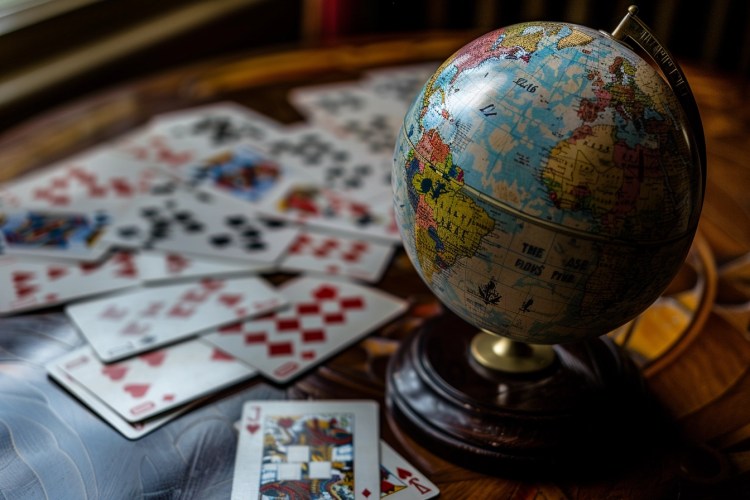Card games transcend mere entertainment, offering a window into the cultural mores, historical epochs, and societal values of civilizations far and wide.
The Cultural Tapestry of Card Games: A Global Perspective

The Cultural Tapestry of Card Games: A Global Perspective
Card games, a cornerstone of leisure activities across the globe, stand as a testament to human creativity and social interaction. These games, transcending mere entertainment, offer a window into the cultural mores, historical epochs, and societal values of civilizations far and wide. From the ancient card games originating in the Tang Dynasty of China to the modern digital platforms that bring traditional games to our fingertips, the evolution of card games mirrors the progression of human society itself.
The Historical Origins of Card Games
The genesis of card games can be traced back to 9th century China, during the Tang Dynasty, where they were likely used for entertainment and possibly for divination purposes. These early iterations of playing cards paved the way for a cultural phenomenon that would, over the centuries, spread across continents and cultures
As trade routes expanded, so too did the spread of card games, reaching the Islamic world and eventually Europe by the 14th century. The Islamic Mamluk cards, with their intricate designs and calligraphy, played a pivotal role in shaping the European playing cards we are familiar with today. This exchange of cultural artifacts underscores the interconnectedness of human societies through the ages.
Europe’s adaptation and evolution of card games brought forth a variety of games, with Italy’s Tarot decks introducing symbolic imagery that extended beyond mere gameplay to embody deeper spiritual and philosophical themes. The 17th and 18th centuries saw card games becoming a staple of nobility and upper-class social circles, reflecting the cultural values and etiquettes of the era
The democratization of card games followed in the 19th century with the advent of printing technology. Playing cards became more accessible, enabling their spread across social classes and embedding them deeply into the fabric of everyday life. This period marked the transformation of card games from an aristocratic pastime to a universal form of entertainment and social interaction.
The Global Landscape of Card Games
The cultural variations of card games are as diverse as the societies that play them. In Asia, games like Mahjong and Hanafuda are not only played for fun but also serve as cultural artifacts, encapsulating centuries of tradition and reflecting the societal norms of their origins. Hanafuda, with its floral motifs representing different months, showcases the Japanese appreciation for nature and the changing seasons. In Europe, the strategic complexities of Poker, Bridge, and Rummy highlight the competitive spirit and analytical mindset, offering a glimpse into the social dynamics and intellectual engagements of European societies.
India’s Seep, a game requiring quick thinking and strategic acumen, and Russia’s Durak, a game embodying strategic challenges and friendly competition, further exemplify the global diversity of card games. Each game, with its unique set of rules and gameplay, offers insights into the cultural fabric of its origin society
The modern era has seen a digital revolution in how card games are played, with online platforms like Solitaires.com offering a vast array of traditional games at our fingertips. This digital transformation has not only preserved these cultural treasures but also facilitated a global exchange of traditional practices, allowing people from different parts of the world to explore and appreciate the rich diversity of card games.
In this global tapestry of card games, brands like GemBet recognize the universal appeal of these games, integrating them into their offerings to connect with a wide audience. By incorporating traditional card games into their platform, GemBet taps into the rich cultural heritage and timeless appeal of these games, offering a bridge between past and present, tradition and innovation.
Social Functions, Symbolism, and Modern Adaptations
In the world of card games, the depth of cultural significance is as varied as the games themselves, intertwining with social functions, embodying rich symbolism, and evolving with modern adaptations. This second part of our exploration delves into the intricate roles these games play in societal interaction, their symbolic meanings, and their transition into the digital era.
Social and Ritualistic Functions
Card games are not merely a source of entertainment; they are woven into the fabric of social life, acting as conduits for bonding, tradition, and cultural transmission. Across the globe, these games are pivotal in bringing people together, from the casual gatherings of friends and family to the more formalized settings of clubs and online communities. For instance, the Indian game of Teen Patti becomes a focal point of festivities during Diwali, bridging generations and reinforcing communal ties. Similarly, in some indigenous cultures, card games are integrated into sacred rituals, serving both as a medium for social connection and a spiritual practice, symbolizing a link to ancestral wisdom and guidance.
The evolution of card games into a structured social activity highlights their role in promoting interaction and camaraderie among participants. These gatherings often transcend mere play, fostering a sense of belonging and community among players. The strategic and competitive nature of card games also encourages mental agility and social skills, further enhancing their appeal and societal value.
Symbolism and Themes
Beyond their social utility, card games are a treasure trove of cultural symbolism and themes. The imagery and motifs employed in games like Tarot or Hanafuda are not arbitrary but are imbued with deep cultural and spiritual significance. In Tarot, for example, each card is a repository of archetypal imagery and themes, reflecting universal human experiences and emotions. The intricate designs of Hanafuda cards, with their seasonal flowers and scenes, not only delight the eye but also convey the transient beauty of nature, echoing the Japanese cultural theme of mono no aware.
This symbolic richness extends to the standard deck of playing cards, where the suits, numbers, and court cards can be interpreted in various ways, reflecting aspects of society, history, and even cosmology. The incorporation of such symbolism into card games allows them to serve as a mirror to the culture, embodying its values, beliefs, and aspirations.
Modern Adaptations and Global Reach
The advent of digital technology has significantly impacted the way card games are played and perceived. Online platforms have democratized access to these games, allowing enthusiasts from different corners of the world to connect, share, and compete. This digital revolution has not only preserved traditional games but also facilitated the creation of new variations, blending cultural elements from across the globe. Websites and apps like Solitaires.com offer a plethora of card games, from the familiar to the obscure, catering to diverse tastes and interests.
The rise of online card gaming platforms has also introduced traditional games to a broader audience, fostering cross-cultural exchange and understanding. For brands like GemBet, the digital landscape offers an opportunity to integrate traditional card game elements into their offerings, enhancing the gaming experience for users and paying homage to the rich cultural heritage of these games.
As we navigate through the digital age, the essence of card games remains unchanged – they continue to bring people together, challenge our minds, and enrich our cultural experience. The transition to online platforms has not diminished their significance but has instead opened new avenues for exploration, innovation, and connection. In embracing both the traditional and the modern, card games remain a vibrant and enduring part of our global cultural tapestry.
The Unifying Power of Card Games and Their Enduring Legacy
In the final part of our exploration into the world of card games, we focus on the unifying power these games hold and their enduring legacy in our increasingly digital society. Card games are more than just pastimes; they are a global phenomenon that bridges cultural divides, fosters community, and continues to evolve, connecting us in ways few other activities can.
Unifying Power Across Cultures
The universal appeal of card games lies in their ability to transcend language barriers and cultural differences. Whether it’s a spirited round of Poker in the United States, a strategic game of Briscola in Italy, or an intense session of Durak in Russia, the fundamental joy of card playing is a shared human experience. This shared experience becomes a powerful force for unity, bringing people together regardless of their background or beliefs.
The adaptability of card games to various social settings also contributes to their unifying power. From casual family gatherings to competitive online tournaments, card games are versatile enough to cater to a wide range of audiences. This adaptability ensures that everyone, from the casual player to the serious enthusiast, can find a place within the card game community.
Enduring Legacy in the Digital Age
The transition of card games into the digital realm has not diminished their popularity; rather, it has cemented their status as a cultural mainstay. Online platforms have made it easier for people to learn, play, and master card games, contributing to their enduring legacy. Furthermore, these platforms have given rise to a new generation of card games, blending traditional elements with innovative gameplay mechanics.
Digital card games also offer an opportunity for cultural preservation, allowing traditional games that might have been lost to time to find a new audience. By digitizing these games, developers can keep the spirit and traditions of the games alive, ensuring that they continue to be a part of our shared cultural heritage.
Card Games and Community Building
One of the most significant impacts of card games is their ability to build and sustain communities. Online forums, gaming platforms, and social media groups dedicated to card games are testament to the vibrant communities that have formed around these games. These communities are not just about competition; they are spaces for sharing strategies, stories, and experiences, fostering a sense of belonging and camaraderie among members.
For brands like GemBet, the community aspect of card games presents a unique opportunity to engage with their audience on a deeper level. By incorporating community-driven features into their platforms, such as tournaments, leaderboards, and social sharing, brands can enhance the user experience and foster a loyal community of gamers.
Conclusion
As we conclude our journey through the cultural significance of card games, it’s clear that these games are more than just a way to pass the time. They are a reflection of our history, a mirror to our culture, and a bridge connecting us across the digital divide. Their ability to evolve while maintaining their core essence is a testament to their enduring appeal.
In a world where digital connections often take precedence over physical ones, card games remind us of the value of real human interaction and the joy that comes from shared experiences. As we shuffle the deck and deal the cards, we’re not just playing a game; we’re participating in a tradition that spans centuries and cultures, embracing the timeless legacy of card games.
Card games have woven their way through the fabric of human culture, proving that despite our differences, we can find common ground at the card table. Whether online or in person, the game continues, and with it, the enduring legacy of card games as a cherished part of our global cultural heritage.








